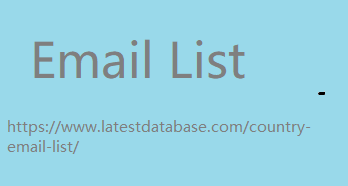Post by account_disabled on Jan 10, 2024 9:58:21 GMT
Try to include many synonyms and variations of the main keyword phrase in the article. For Google, this is a signal that we comprehensively cover a given issue. Additionally, we will better position ourselves for different variants of the main keywords. Include variations and synonyms of the main phrase in the text. Part 4 – User Experience (UX) I'm amazed how often web editors overlook this point. A few graphics, short paragraphs and the right font are simple things that will significantly improve the appearance of our article. I will now present you some of the most important tips. 25. Short paragraphs This is the easiest change to implement and makes reading and learning the text much easier. There's nothing worse than a big, uninterrupted wall of text. Don't be afraid to make paragraphs every 3, 2 or even 1 sentence.
The human eye needs a white space to rest from time to time. Paragraphs also help you organize knowledge better. Create short paragraphs every 1-3 sentences. 26. Lots of headlines Headlines are great opportunities to weave in side phrases. Additionally, they make reading Email List much easier and logically segregate content. They make it easier for the reader to find the issue they are interested in, which is especially important in the case of longer content. It is important to maintain the appropriate structure of headings, which I wrote about earlier. Don't be afraid to create multiple headlines. They are very helpful from an SEO perspective and usability for the reader. 27. Font and headings in the appropriate size Another very simple change to implement, which will significantly increase the readability of our content.

It is recommended that the minimum font size be 16 px. Depending on the client, we balance between 18-20 px. If you use a 12 px font, increasing the size may seem strange at first. However, know that this is a very important and positive change. Headings should be significantly different in size from the text. How much? Most often, the h2 header is 10 px larger than the font. So the text is 18 px, the h2 heading is 28, the h3 is 26, and the h4 is 25. The minimum font size is 16 px. Headers should significantly differ in size from the text by about 10px. 28. Bold most important sentences Bold allows Google to understand what parts of the article are important. For readers, it is a clear signal where the most important content is located. Also remember that most people (including you and me probably) only scan texts, looking for the most important information.
The human eye needs a white space to rest from time to time. Paragraphs also help you organize knowledge better. Create short paragraphs every 1-3 sentences. 26. Lots of headlines Headlines are great opportunities to weave in side phrases. Additionally, they make reading Email List much easier and logically segregate content. They make it easier for the reader to find the issue they are interested in, which is especially important in the case of longer content. It is important to maintain the appropriate structure of headings, which I wrote about earlier. Don't be afraid to create multiple headlines. They are very helpful from an SEO perspective and usability for the reader. 27. Font and headings in the appropriate size Another very simple change to implement, which will significantly increase the readability of our content.

It is recommended that the minimum font size be 16 px. Depending on the client, we balance between 18-20 px. If you use a 12 px font, increasing the size may seem strange at first. However, know that this is a very important and positive change. Headings should be significantly different in size from the text. How much? Most often, the h2 header is 10 px larger than the font. So the text is 18 px, the h2 heading is 28, the h3 is 26, and the h4 is 25. The minimum font size is 16 px. Headers should significantly differ in size from the text by about 10px. 28. Bold most important sentences Bold allows Google to understand what parts of the article are important. For readers, it is a clear signal where the most important content is located. Also remember that most people (including you and me probably) only scan texts, looking for the most important information.
